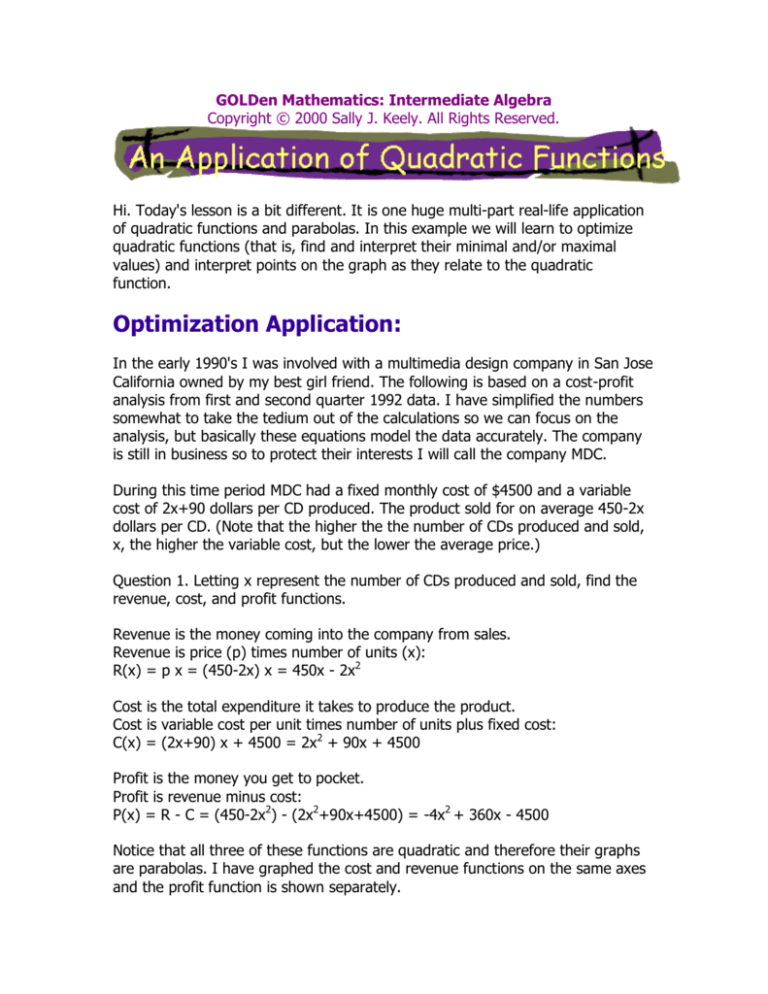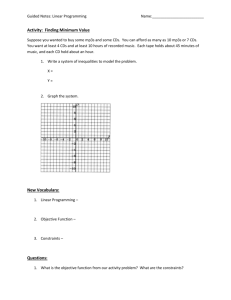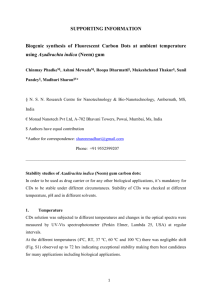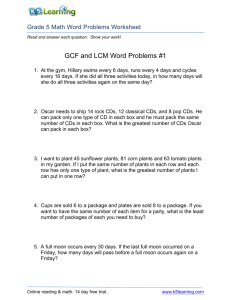
GOLDen Mathematics: Intermediate Algebra
Copyright © 2000 Sally J. Keely. All Rights Reserved.
Hi. Today's lesson is a bit different. It is one huge multi-part real-life application
of quadratic functions and parabolas. In this example we will learn to optimize
quadratic functions (that is, find and interpret their minimal and/or maximal
values) and interpret points on the graph as they relate to the quadratic
function.
Optimization Application:
In the early 1990's I was involved with a multimedia design company in San Jose
California owned by my best girl friend. The following is based on a cost-profit
analysis from first and second quarter 1992 data. I have simplified the numbers
somewhat to take the tedium out of the calculations so we can focus on the
analysis, but basically these equations model the data accurately. The company
is still in business so to protect their interests I will call the company MDC.
During this time period MDC had a fixed monthly cost of $4500 and a variable
cost of 2x+90 dollars per CD produced. The product sold for on average 450-2x
dollars per CD. (Note that the higher the the number of CDs produced and sold,
x, the higher the variable cost, but the lower the average price.)
Question 1. Letting x represent the number of CDs produced and sold, find the
revenue, cost, and profit functions.
Revenue is the money coming into the company from sales.
Revenue is price (p) times number of units (x):
R(x) = p x = (450-2x) x = 450x - 2x2
Cost is the total expenditure it takes to produce the product.
Cost is variable cost per unit times number of units plus fixed cost:
C(x) = (2x+90) x + 4500 = 2x2 + 90x + 4500
Profit is the money you get to pocket.
Profit is revenue minus cost:
P(x) = R - C = (450-2x2) - (2x2+90x+4500) = -4x2 + 360x - 4500
Notice that all three of these functions are quadratic and therefore their graphs
are parabolas. I have graphed the cost and revenue functions on the same axes
and the profit function is shown separately.
Question 2. Find the break-even point(s). Do so both algebraically and
graphically.
Companies break-even when the revenue equals the cost. So, let R=C and solve
for x.
450x - 2x2 = 2x2 + 90x + 4500
-4x2 + 360x - 4500 = 0
Hmm, that's interesting. We have profit equal to zero (P=0). I guess that is an
alternate way to algebraically find the break-even point(s). Makes sense! Let's
keep going,
[-4x2 + 360x - 4500] / -4 = [0] / -4
x2 - 90x + 1125 = 0
(x - 15)(x - 75) = 0
x = 15, 75
Remember, we could have used the quadratic formula to solve x 2-90x+1125=0 if
we couldn't get it to factor (or didn't feel like trying!)
So, MDC breaks even by producing and selling either 15 CDs per month or 75.
Do you see these values as significant points in the graphs shown above? The
revenue and cost functions intersect each other at x=15 and x=75 and the profit
function crosses the x-axis at x=15 and x=75. Cool!
If you have access to a graphing calculator or online grapher, try verifying these
values graphically. Since break-even points are where R=C, find the intersection
points of the revenue and cost functions using the "intersection" feature.
We also could use P=0 to find break-even point(s), so try verifying the solutions
this way graphically too. Find the points where the profit is zero, i.e. the xintercept points of the profit function, using the "zero" feature on your grapher.
If you want to try this graphical approach on a different brand or model
calculator or an online graphing program, you can probably figure out how to
apply these steps to your grapher. But if not, refer to the manual or post to the
discussion board and I or someone will try to give you a hand! Graphing
calculators and graphing software are a wonderful tool to analyze real-world
applications where the equations often involve decimals and/or fractions and so
the algebraic approach is very tedious and messy.
Question 3. What happens to profits when MDC produces and sells between 15
and 75 CDs? Less than 15? More than 75?
Examine the revenue and cost graphs. When MDC produces and sells between
15 and 75 CDs, which is higher, the revenue or the cost? in this region the
revenue graph is "above" the cost graph, so revenues are higher and MDC is
making a profit. But, when MDC produces and sells less than 15 CDs or more
than 75 CDs the cost graph in these regions is above the revenue graph, so costs
are higher than revenues and MDC is losing money.
Question 4. How can profit and loss be seen in the graph of the profit function?
This is easy! MDC makes a profit when the graph of the profit function lies above
the x-axis (i.e., where P(x)>0) and loses money when the profit graph lies below
the x-axis (i.e., where P(x)<0).
Question 5. What level(s) of sales yield a maximum revenue?
Since the graph of the revenue function is an upside down parabola, the
maximum revenue corresponds to the vertex of this parabola. Let's use the
vertex formula Vx=-b/(2a) to find the x-coordinate of the vertex.
R(x) = 450x - 2x2 = -2x2 + 450x in general form.
So, a=-2 and b=450.
Vx = -b/(2a) = -(450)/(2*-2) = -450/-4 = 112.5
Thus selling 112.5 CDs will maximize the monthly revenue.
But wait a minute. If we produce 112.5 CDs, how much will it cost?
C(112.5)=2(112.5)2+90(112.5)+4500=$39,937.50
What is the revenue from selling 112.5 CDs?
R(112.5)=450(112.5)-2(112.5)2=$25,312.50.
That is a loss of $14,625, ouch! But of course we will have a loss at 112.5 since
it is not in the profit range we found above (15 < x < 75). This illustrates that
maximizing revenue is not a good plan. We should seek to maximize profit ...
Question 6. What level(s) of production and sales will maximize profits?
Again, since the graph of the profit function is an upside down parabola, the
maximum profit corresponds to the vertex of this parabola. Let's use the vertex
formula Vx=-b/(2a) to find the x-coordinate of the vertex.
P(x) = -4x2 + 360x - 4500 in general form.
So, a=-4 and b=360.
Vx = -b/(2a) = -(360)/(2*-4) = -360/-8 = 45
Thus producing and selling 45 CDs will maximize the monthly profit.
Question 7. What is the maximum monthly profit?
The maximum profit occurs when x=45, so plug this into the profit function:
P(45)=-4(45)2+360(45)-4500=$3600
Question 8. Verify this maximum profit graphically.
We need to find the coordinates of the vertex of the graph of the profit function
graphically. To find it use the "maximum" feature of your grapher to find the
coordinates of the peak of the graph. Are you able to verify that the vertex is at
(45,3600)? Notice that the x-coordinate of the vertex gives the number of CDs
that need to be produced and sold to maximize profit and the y-coordinate gives
the actual max profit in dollars.
Question 9. What price per CD is associated with this maximum profit?
Price was given as p=450-2x, so plug x=45 in to get a price of 450-2(45)=$360
per CD.
I know this sounds expensive, but these weren't normal music CDs, these were
CDs full of animated graphics and short video segments individually designed for
that particular client. Believe me, now that MDC has grown and prospered, their
CDs sell for hundreds sometimes thousands more!
I hope you enjoyed this application and analysis. Do you now have a clear
connection between the function values and the points on the corresponding
parabola? Are you able to interpret these points in terms of the specific
application? I'm a very visual person so its useful to me to get a visual grasp on
the algebraic processes that we have been studying :) I hope the graphical
approach seen here helps motivate the algebraic processes for you too. See you
next time!








